From a genealogical perspective, among all pre-1914 Polish-Jewish vital records, the marriage registers hold special significance. They typically offer a wealth of information about the newlyweds and their families, while also serving as a valuable roadmap to further resources.
Central Poland being, up to 1914, a part of the Russian Empire, the records are all handwritten in Russian, some of them in such a manner that even a native Russian speaker will find it challenging to decipher them. But, again, their importance is such that they are well worth investing in hiring a person who can translate them into English.
Let’s take, for example, the 1894 Rypin Jewish vital records register, which is to be found on the Internet site of the Polish Genealogical Society (PTG) (https://metryki.genealodzy.pl) which also hosts sets of Jewish vital records from numerous smaller localities in Poland (the original records are kept at the Włocławek Branch of the Polish State Archives in Toruń, file 71/406/0). As regards Rypin, a town in north-central Poland, about 50 km east of Toruń, the site has Jewish vital records from 1826 until 1911 with some gaps here and there and the corresponding "Alegata" (Attachments) file. And here is the first marriage registration of 1894. Please note that all the dates are, of course, according to the Julian calendar. (The translated text comes in bold font; the rest are my comments.)
Pre-1914 Jewish Marriage Records from Central Poland
It happened in the town of Rypin on January 7, 1894 [this is not the marriage date but the date when the announcement of the marriage was made to the registrar]. It was announced [here comes a rather long paragraph providing the names and the whereabouts of two witnesses which I omit here] that on January 4 of this year in the town of Rypin a religious marriage ceremony took place between Abram Jakow Joskowicz, merchant, bachelor, 18 years of age, son of Moszek Wolf and Liba Chana nee Winer Joskowicz, permanent residents of the town of Pabianice in the Piotrkow Gubernia and Maria Braun, unmarried, 17 years of age, daughter of Wigdor and Roza nee Pozner, residents of Rypin.
The marriage was preceded by three announcements in the Pabianice Synagogue on 20 and 27 November and also on 4 December last year and in the Rypin Synagogue on 4, 11 and 18 December of the same year [i.e. 1893].
The religious ceremony was performed by the Rypin Rabbi Hersz Lurie.
The newlyweds announced that they had signed a prenuptial agreement in the office of the Rypin notary Anton Gralewski on 4 January of this year under number 12.
The parents of the newlyweds verbally granted their permission before the ceremony.
After being read, this document was signed by all the present persons [And here come five signatures: the rabbi, the newlyweds and the two witnesses.]
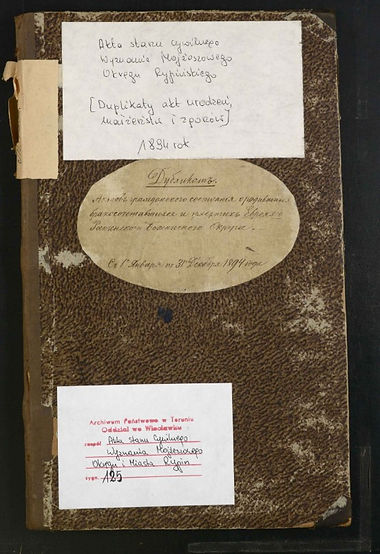
The 1894 Rypin register of Jewish births, marriages and deaths. Registration of marriages starts on page 35 of the register (Source: PTG).
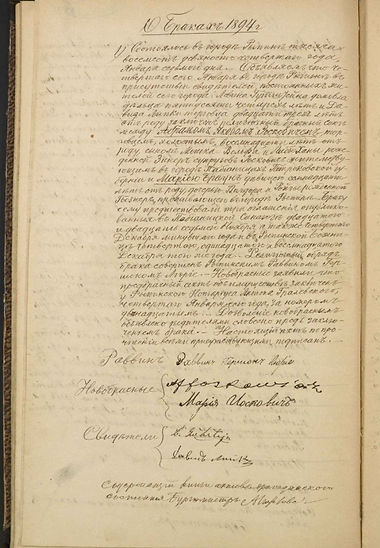
The first marriage registration in Rypin in 1894; Abram Jakow Joskowicz and Maria Braun (Source: PTG).
It is worth noting several starting points for potential additional research:
1. All the marriage entries have supporting documents which are filed in a separate file called “Alegata” (Attachments) which was also digitized on the PTG site (the original records are kept at the Włocławek Branch of the Polish State Archives in Toruń, file 71/406/0). The “Alegata” file typically includes confirmations of the announcements made in synagogues and some reference to the newlyweds’ birth registrations. In cases where one of the newlyweds was not born in the locality where the marriage took place the “Alegata” file also includes a copy of his or her birth registration. This is what happened in our case; the groom was not born in Rypin and so the “Alegata” file has a copy of his birth registration from Lodz. The document provides the exact date of birth for Abram Jakow Joskowicz (28 December 1875) and some additional information about his parents. Since the bride was born in Rypin, her birth certificate was easily accessible to the registrar, who simply noted on the margin of one of the “Alegata” documents that her birth registration can be found in the 1875 register under number 16.
2. The reference to the prenuptial agreement could be of much importance, so I ordered it from the Włocławek Branch of the Polish State Archives in Toruń, which holds the Papers of the notary Antoni Gralewski. In paragraph 3 of the agreement, the groom declares that “right now he has no possessions,” and in paragraph 4, the bride states that she brings with her into the marriage union furniture made of chestnut wood, gold and silver jewelry, and household appliances valued at a total of 2,000 rubles.
3. The signatures of the newlyweds on the marriage registration can provide some insight into their education. Firstly, the mere existence of signatures suggests literacy, which was not common at the time. On many marriage registrations, instead of signatures, there is a remark by the registrar: “The newlyweds are illiterate.” Secondly, I noticed that the bride’s signature is in Russian, while the groom signed in Polish. This could indicate that the bride attended a state school where the language of education was Russian, while the groom received his education from a tutor at home. Regardless, it seems evident that we are dealing here with quite well-to-do Jewish families, at least on the side of the bride.
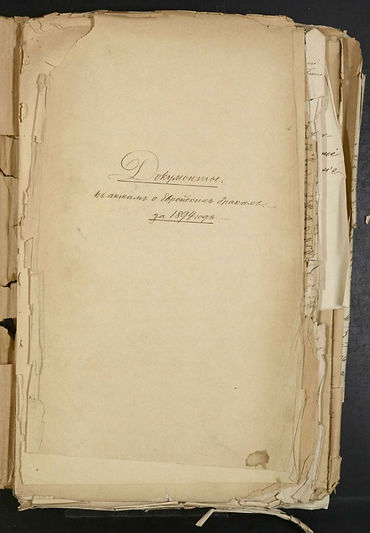
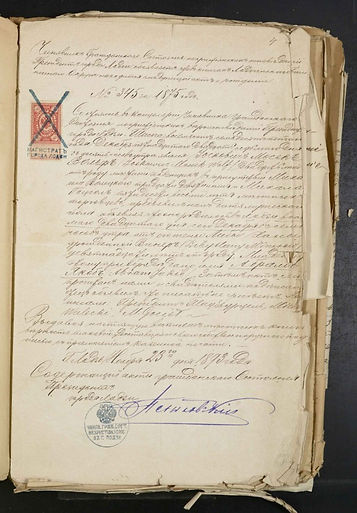
Copy of Abram Jakow Joskowicz' birth registration to
be found in the 1894 Rypin "Alegata" file (Source: PTG).
The 1894 Rypin "Alegata" file (Source: PTG)
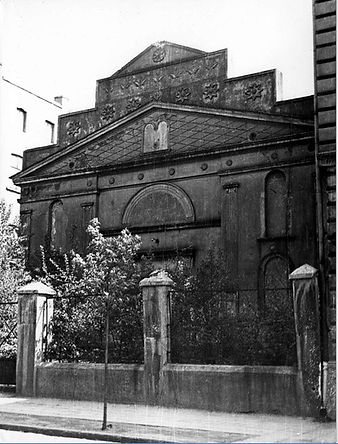
The Pabianice synagogue on the post-WWII photograph (Source: fotopolska.pl)

The last page of the 4-page prenuptial agreement which also displays the signatures of the newlyweds' parents (Source: Włocławek Branch of the Polish State Archives in Toruń, The Papers of notary Antoni Gralewski, file 71/994/0/-/42)
(Written in March 2024.)